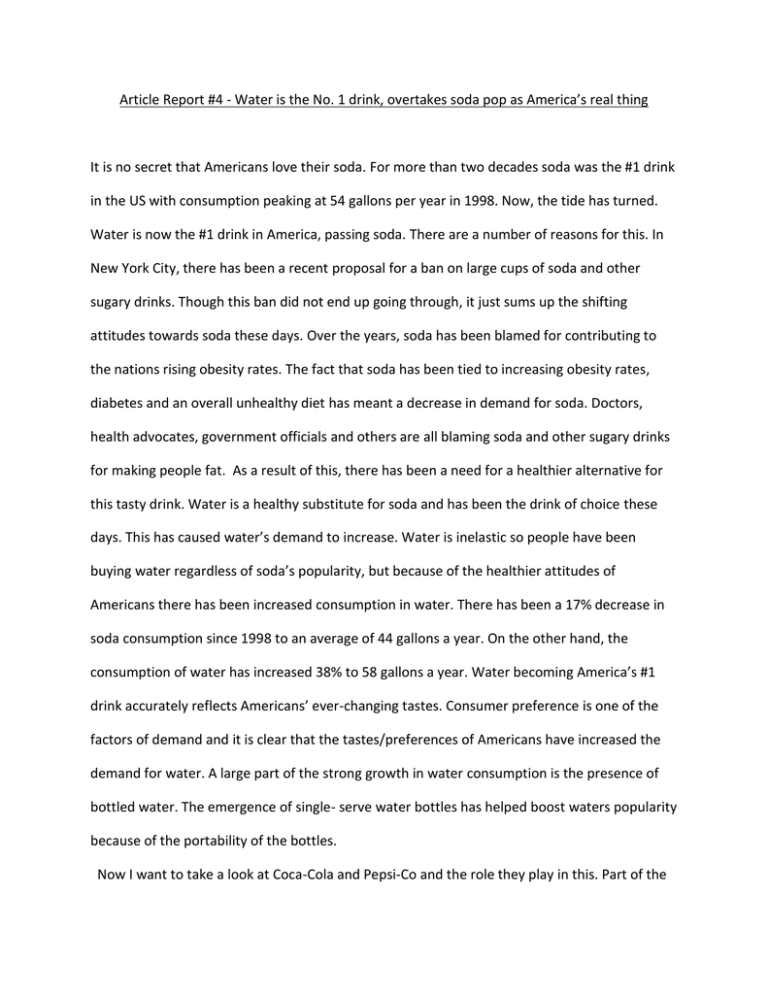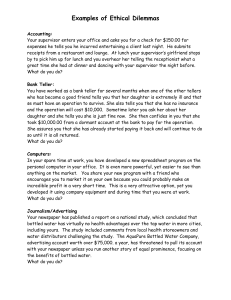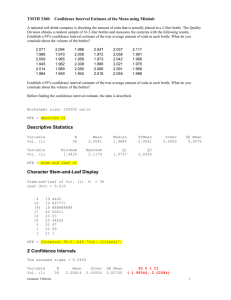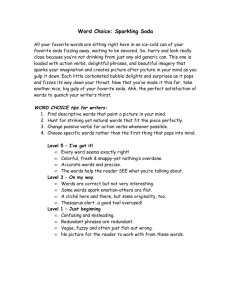Article Report #4 - Water is the No. 1 drink, overtakes soda pop as
advertisement

Article Report #4 - Water is the No. 1 drink, overtakes soda pop as America’s real thing It is no secret that Americans love their soda. For more than two decades soda was the #1 drink in the US with consumption peaking at 54 gallons per year in 1998. Now, the tide has turned. Water is now the #1 drink in America, passing soda. There are a number of reasons for this. In New York City, there has been a recent proposal for a ban on large cups of soda and other sugary drinks. Though this ban did not end up going through, it just sums up the shifting attitudes towards soda these days. Over the years, soda has been blamed for contributing to the nations rising obesity rates. The fact that soda has been tied to increasing obesity rates, diabetes and an overall unhealthy diet has meant a decrease in demand for soda. Doctors, health advocates, government officials and others are all blaming soda and other sugary drinks for making people fat. As a result of this, there has been a need for a healthier alternative for this tasty drink. Water is a healthy substitute for soda and has been the drink of choice these days. This has caused water’s demand to increase. Water is inelastic so people have been buying water regardless of soda’s popularity, but because of the healthier attitudes of Americans there has been increased consumption in water. There has been a 17% decrease in soda consumption since 1998 to an average of 44 gallons a year. On the other hand, the consumption of water has increased 38% to 58 gallons a year. Water becoming America’s #1 drink accurately reflects Americans’ ever-changing tastes. Consumer preference is one of the factors of demand and it is clear that the tastes/preferences of Americans have increased the demand for water. A large part of the strong growth in water consumption is the presence of bottled water. The emergence of single- serve water bottles has helped boost waters popularity because of the portability of the bottles. Now I want to take a look at Coca-Cola and Pepsi-Co and the role they play in this. Part of the reason why bottled water consumption has increased is because of Coca-Cola and Pepsi-Co and their marketing. Before I go any further, I must note that when it comes to the general soda industry, Coca-Cola and Pepsi-Co are part of a differentiated oligopoly since there are few soda producers and entry into this market is difficult. On the other hand, when it comes to bottled water (distilled water) Coca-Cola and Pepsi-Co are involved in perfect competition since there are many producers (Dasani, Aquafina, Evian, Nestle, Arrowhead etc.) selling an identical product. Also, soda and bottled water are private goods because their benefits can be denied to non-buyers and the consumption by one person reduces the amount available for others. These two companies have millions of dollars available to spend on marketing so people are being convinced to buy more bottled water as a result. As much as these two companies want consumers to buy their bottled water (Coke-Dasani/Vitamin Water and Pepsi-Co-Aquafina), they want even more for consumers to buy their sodas. This is because sodas are more profitable than water. Consumers buy whichever water is the cheapest but that is not the case for soda. This is proven by the fact that soda sales are almost 5 times as large as bottled water sales while there volume of sales are only twice as large. These companies are now investing in countries such as China and India because soda is gaining popularity there. In terms of the profits of these companies, they are accounting profits. When I say that soda sales produce more profit then bottled water, implicit costs are not taken into account. If implicit costs were taken into account then this would become economic profit, which is total revenue minus both explicit and implicit costs. Another thing I would like to talk about regarding soda and bottled water, particularly bottled water, are the external costs of these drinks. Soda and bottled water have external costs associated with them because there are people who don’t recycle bottles and cans which consequently has a negative impact on the environment. People other than the producers and consumers experience the effects of this for many reasons. For example, if someone is taking a leisurely walk in their neighborhood and they come across cans or bottles on the sidewalk, this could anger this person because it is affecting their enjoyment of walking in their neighborhood where they live. Most people probably wouldn’t like to see empty cans and bottles scattered around their neighborhood whether it’s because it is not nice to look at or the negative environmental effects. This doesn’t affect the producers though because they don’t care where the bottles or cans end up, they just want to make as much money as they can…or from an economic standpoint maximize total economic profits. Overall, mainly due in part to serious health concerns and consumers changing tastes/preferences, water has taken over soda for the prestigious distinction of America’s #1 drink. In my opinion, water will stay at #1 for a while because Americans are becoming more aware of health concerns and the importance of a healthy diet. After all, water is the one thing you need to consume to survive.




